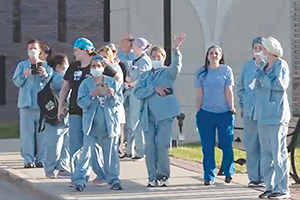By LISA EISENHAUER
As COVID-19 was sweeping across the nation, Livonia Mayor Maureen Brosnan and the community's other leaders were unaware that the suburban Detroit city was getting slammed especially hard by the pandemic.

Brosnan
"We kind of thought that everybody else around us was dealing with the same dynamic that we were," recalled Brosnan.
But the patient load was so heavy that St. Mary Mercy Livonia, the only hospital in the city, had nearly doubled the size of its 16-bed intensive care unit by early April to meet demand and added a "comfort care unit" for the dozens of patients dying from the virus.

St. Mary Mercy Livonia staff react to a tribute to their heroism from first responders. Police and fire department vehicles ringed the hospital to show support.
When comparative numbers started coming in from the state, Brosnan and others learned that the COVID case and death rates for Livonia were above those of any Michigan city except Detroit. At its peak on April 9, the death rate for people who contracted the virus in the city of 96,000 reached 18%, Brosnan said. The fatality rate for patients with COVID was at 4% nationwide in mid-July, according to Johns Hopkins University & Medicine Coronavirus Resource Center.
Eye of the storm
The virus might have been even more devastating if not for the joint efforts of city officials and leaders of St. Mary Mercy, where Brosnan chairs the board of directors. The hospital is part of the Saint Joseph Mercy Health System, a subsidiary of Trinity Health.
Working together, city and hospital leaders were able to find local companies to make personal protective gear for health care workers. As COVID spread rapidly in the city's long-term care facilities, St. Mary Mercy set up a task force to contain the infection and invited participation from the city.
The hospital's infectious disease experts consulted on setting up quarantine units at 15 long-term care facilities for residents with COVID and on additional steps to protect other residents from contagion. The expertise also was used to figure out burn rates on protective supplies.
The hospital and city worked together to identify potential sites for COVID units outside the hospital. Fortunately, the broadside the city had taken from the pandemic eased by mid-May and the plans for those extra care spaces could be put on hold.
Nevertheless, Brosnan said at the time: "We by no means consider ourselves out of crisis management mode."

Griffin
Dr. Matt Griffin, chief medical officer of St. Mary Mercy, said: "We kind of feel that we're at a stable point. We're certainly not done with this and none of us anticipate that we'll be done any time very soon."
On its busiest day, April 7, the hospital was treating 152 inpatients with COVID and diverting others to the five other southeastern Michigan hospitals in the Saint Joseph Mercy Health System. By mid-July, the number of inpatients being treated for COVID had dropped to one to three patients on average .
Bracing for the blow
Before the surge hit Livonia, hospital leaders watched the virus inundate hospitals in Seattle and then New York. "Pretty quickly, in the first couple of days, we were convinced that we were going to face a very similar crisis due to our patient population," Griffin said.
Livonia's population has a high rate of comorbid conditions such as diabetes, hypertension, obesity and pulmonary disease and many residents are elderly, making them especially susceptible to a poor outcome from COVID.
Within three days of seeing its first patients with the infection, the hospital set up a screening site outside of its emergency department. Few of the people who came through were actually tested due to restrictions on who was eligible for testing; and, for those who were, the results took days to get. The screening staff nevertheless was able to identify those who might be infected, get patients in the direst conditions into hospital care and educate those who had signs of the infection on how to self-quarantine.
Griffin said that outdoor screening site was one of several ideas pitched by staff and adopted by St. Mary Mercy's leaders that proved key in getting the hospital through its worst days of the pandemic surge. Another was to turn an area that had once housed the emergency department but was more recently being used for storage into a second ICU. At staff suggestion, the hospital repurposed what had been a chemical dependency unit into a hospice unit for patients with COVID, who themselves or whose families opted against aggressive medical intervention.
"Sad as it is that we needed it, I think one of our biggest successes during this event was our comfort care unit," Griffin said, referring to the unit for end-of-life care.
The unit's team of specialists — physicians, nurses and support staff — cared for more than 100 patients over the period of four to six weeks, providing them a peaceful end to their lives, Griffin said.
Community pitches in
As St. Mary Mercy was in the throes of the patient surge from the pandemic, concerns about supplies arose. Shortages of medical necessities were being reported across the globe and even Trinity Health's well-connected and reliable supply chain couldn't fully meet the need for goods like respirator masks and surgical gowns.
Griffin said St. Mary Mercy's leaders paid close attention to ensure that protective gear was being conserved without violating federal guidelines; there was no easy way to replenish supplies.

Spivey
That's one of the ways the collaboration with the city paid off. With the hospital providing prototypes, city officials were able to tap local companies to produce scarce items for the hospitals and long-term care facilities. Two firms made plastic face shields and others made gowns and surgical masks.
"The community really provided support through the manufacturing sector," hospital President David Spivey recalled.
Better together
First responders from Livonia and other localities in southeast Michigan turned out in force April 16 to honor and thank the frontline caregivers at St. Mary Mercy. The city's video of the tribute, which included prayers for the first responders and families impacted by COVID, can be viewed at chausa.org/chworld.
Brosnan called her dual connection with the city and the hospital, one of Livonia's top five employers, "an ideal arrangement" because she was able to help them merge their expertise and resources. She has served on either the hospital's or Saint Joseph Mercy's board for 19 years. She said she finds personal fulfillment in the spirituality-based mission of Catholic hospitals.
"The big part of how, as a leader, I was able to get through, and continue to get through, this crisis is having that background and having that foundation," she said. "And knowing that I had a Catholic hospital in my backyard to help me do it."